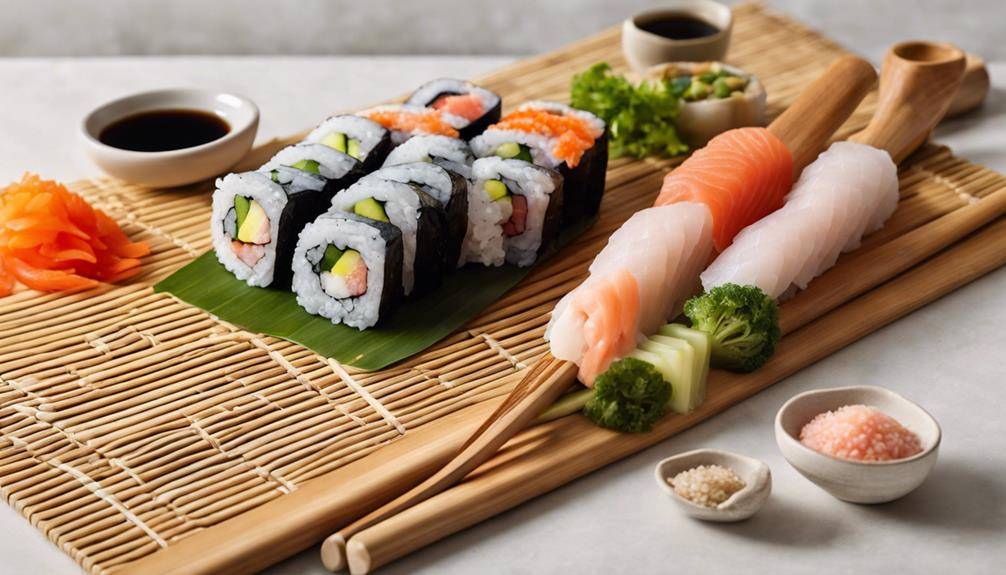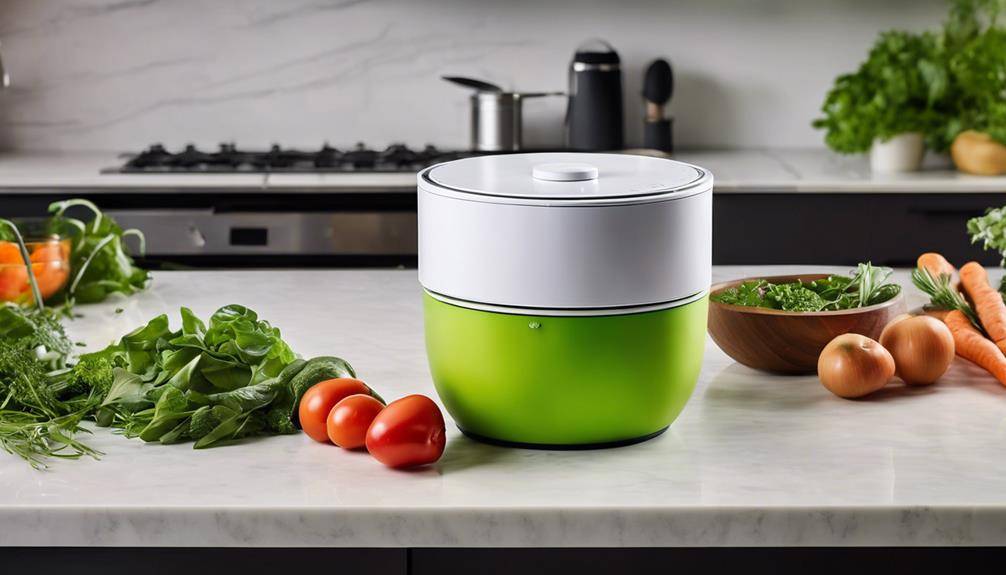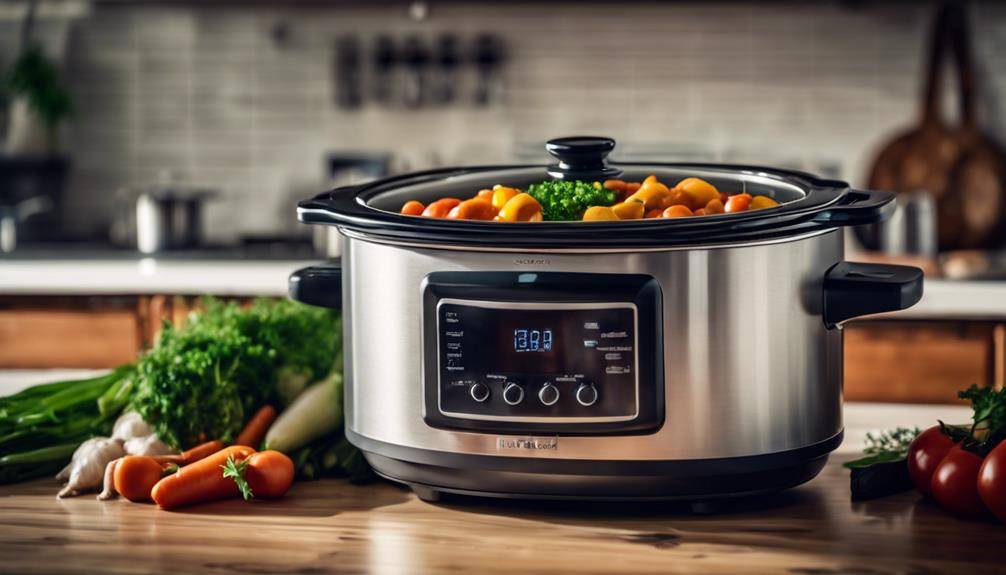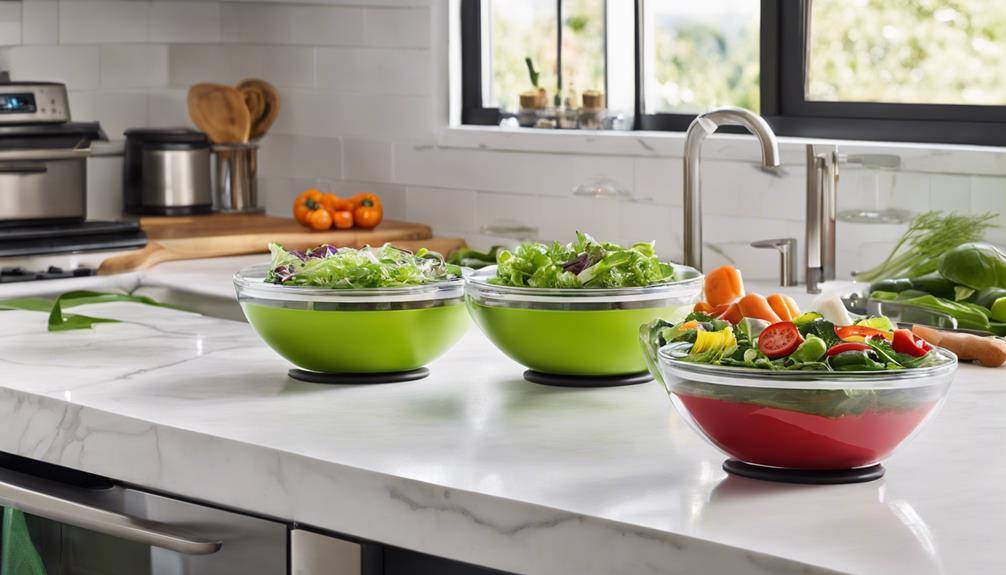Amazing Wireless Kitchen Thermometers For Busy Cooks

Wireless Kitchen Thermometers For Busy Cooks, are game-changers for busy cooks like you. They let you monitor your food’s temperature from a distance, so you don’t have to hover over the stove. With alerts for your desired temperatures, you can prevent overcooking and focus on other tasks without stress. These devices offer easy setup, user-friendly apps, and a range of probes suitable for various cooking methods. Plus, their clear displays make tracking simple. If you appreciate efficiency in the kitchen, you’ll want to explore how these innovative tools can transform your cooking experience.
Benefits of Wireless Thermometers
Why struggle with traditional thermometers when wireless options offer so much convenience? Wireless thermometers are designed to make your cooking experience smoother and more efficient. You can monitor your food’s temperature from a distance, allowing you to multitask without running back and forth to the oven or grill. This means less stress and more time to focus on your other culinary creations.
With wireless convenience, you no longer need to stand right next to your cooking appliance, anxiously peeking through the door. Instead, you can use your smartphone or a dedicated monitor to keep tabs on your dish from anywhere in your home. This freedom not only enhances your cooking efficiency but also lets you enjoy the process even more, whether you’re entertaining guests or prepping a family meal.
Another significant benefit is the precision that wireless thermometers provide. Many models come with advanced features, like alerts when your food reaches the desired temperature. This guarantees you won’t accidentally overcook or undercook your dishes, leading to perfectly cooked meals every time. Plus, most wireless models are easy to set up and use, so you won’t spend extra time deciphering complicated instructions.
How Wireless Thermometers Work
Wireless thermometers operate by utilizing a combination of sensors and wireless technology to monitor the temperature of your food in real time. At their core, these devices use advanced sensor technology to detect the internal temperature of your meat, pastries, or any dish you’re preparing. The sensors are typically made from thermocouples or thermistors, which convert temperature changes into electrical signals. These signals are then processed and sent wirelessly, allowing you to keep an eye on your cooking without being tethered to the kitchen.
Wireless communication plays a vital role in this process. The thermometer usually connects to a smartphone or a dedicated receiver via Bluetooth or Wi-Fi. This connection transmits the temperature data, enabling you to track it from a distance. You can easily monitor your meal while multitasking or relaxing in another room without constantly checking the oven or grill.
Some models even offer alerts or notifications when your food reaches the desired temperature, ensuring you don’t overcook your meal. Additionally, many wireless thermometers come with apps that provide cooking tips, temperature guides, and cooking time estimators, enhancing your overall cooking experience.
Key Features to Consider
When choosing a wireless kitchen thermometer, several key features can greatly enhance your cooking experience. First off, take into account the range of the wireless technology. A longer range allows you to monitor your food from various rooms, giving you true cooking convenience. Look for models with a Bluetooth or Wi-Fi connection that can seamlessly connect to your smartphone or tablet.
Next, pay attention to the accuracy and response time. You want a thermometer that provides precise readings quickly, so you can make timely adjustments to your cooking. Many thermometers offer instant readings, which can be essential for achieving the perfect doneness.
Don’t forget about the display. A clear and easy-to-read screen can make a big difference, especially when you’re multitasking in the kitchen. Some models even come with backlighting for low-light situations, which is a fantastic convenience.
Another feature to keep in mind is the probe design. Look for durable, heat-resistant materials and a flexible cord if you’re doing long cooks, like smoking meats. Additionally, some thermometers come with multiple probes, allowing you to monitor different dishes simultaneously.
Lastly, think about the app compatibility. A well-designed app can offer cooking tips, preset temperatures for various meats, and alerts when your food is ready. With these features in mind, you’ll find a wireless kitchen thermometer that elevates your cooking game and fits your busy lifestyle perfectly.
Top Wireless Thermometer Brands
Many home cooks often turn to trusted brands when selecting a wireless kitchen thermometer, as reliability and performance are essential for achieving perfect results. Several top brands dominate the market, each offering unique features that cater to different cooking styles and preferences.
One brand you might consider is ThermoWorks. Known for its accuracy and quick response times, ThermoWorks thermometers often receive high praise in brand comparisons. Their ThermoPop and Smoke models are particularly popular among both novice and experienced cooks.
Another strong contender is Meater. This brand stands out due to its sleek design and Bluetooth capabilities, allowing you to monitor your food from your smartphone. Their wireless meat thermometer is ideal for grilling and roasting, giving you peace of mind while you focus on other tasks.
If you’re looking for budget-friendly options, look at the brands like Inkbird. They offer reliable performance without breaking the bank, making them a great choice for casual cooks. Their wireless thermometers often come with multiple probes, which is handy when cooking large meals.
Lastly, don’t overlook the accuracy and features of the Weber brand, especially if you’re into grilling. They provide thermometers that are designed specifically for outdoor cooking, offering excellent durability and performance.
Comparing Price Points
Choosing a wireless kitchen thermometer often involves weighing performance against cost. You’ll find a range of options, from budget-friendly models to those boasting premium features. Understanding your cooking needs is essential in making a smart investment.
If you’re a casual cook or just starting out, budget options can serve you well. These thermometers typically offer basic temperature readings and are easy to use. They’re perfect for grilling or baking when you don’t need advanced functionality. Many budget models still provide accurate readings, making them a reliable choice without breaking the bank.
On the other hand, if you’re an avid cook who enjoys experimenting with different recipes, investing in a thermometer with premium features might be worthwhile. These models often come with enhanced connectivity, allowing you to monitor temperatures via smartphone apps or even have multiple probes for different dishes. Features like programmable alarms, high precision, and extended range can elevate your cooking experience, ensuring you get perfectly cooked meals every time.
Ultimately, you’ll want to assess how frequently you’ll use the thermometer and what features are most important for your cooking style. While it might be tempting to go for the cheapest option, remember that spending a little extra on a model with premium features could save you time and frustration in the long run. Balancing your cooking habits with your budget will help you find the right wireless kitchen thermometer for your kitchen.
Wireless Vs. Traditional Thermometers
When choosing between wireless and traditional thermometers, you’ll want to contemplate ease of use, accuracy, and connectivity options. Wireless models often offer greater convenience with their range, but traditional ones can be just as precise if used correctly. Let’s break down these factors to see which type might work best for you.
Ease of Use
Wireless kitchen thermometers offer a level of convenience that traditional models simply can’t match. When you’re juggling multiple tasks in the kitchen, the last thing you want is to be tethered to a probe. With wireless thermometers, you can monitor your food from a distance, allowing you to focus on prepping other dishes or entertaining guests.
These devices often feature user-friendly designs, making them accessible for cooks of all skill levels. You’ll appreciate how easy it is to set up and start using them right away. Many models come equipped with intuitive interfaces, ensuring you can quickly understand how to navigate settings, adjust temperatures, and set timers without any fuss.
Plus, wireless thermometers often come with smartphone apps, giving you even more flexibility. You can receive alerts, check temperatures, and adjust settings from your phone, all while enjoying a little downtime away from the stove. This ease of use transforms the cooking process, helping you to cook more efficiently and effectively. Overall, if you’re looking for a way to streamline your kitchen experience, investing in a wireless thermometer is a smart move.
Accuracy Comparison
Comparing the accuracy of wireless thermometers to traditional models reveals some important differences that can impact your cooking. Wireless thermometers often incorporate advanced calibration techniques that enhance their precision. These devices are designed to provide real-time temperature readings, which means you can monitor your dish without constantly opening the oven or grill.
Traditional thermometers, while reliable, may require manual calibration to guarantee accuracy. This process can be time-consuming and sometimes leads to errors if not done correctly. Additionally, they might not be as responsive to rapid temperature changes, which can affect how evenly your food cooks.
Temperature sensitivity is another vital factor. Wireless thermometers are typically more sensitive to slight changes in temperature, giving you better control over your cooking. You’ll find that this sensitivity helps prevent overcooking or undercooking your meals.
Range and Connectivity
Range and connectivity play an essential role in the effectiveness of kitchen thermometers. When you’re using a wireless thermometer, you want to guarantee it can maintain a strong signal, even if you step away from the grill or oven. A good wireless thermometer typically offers a range of up to 300 feet, allowing you to move around your kitchen or patio without constantly checking the display.
However, keep in mind that obstacles like walls or appliances can weaken signal strength, leading to connectivity issues. If you’re cooking in a large space or have multiple levels in your home, it’s wise to choose a thermometer with a robust range.
Traditional thermometers, on the other hand, have no range limitations since they provide direct readings. Yet, they require you to be close by to monitor your food’s temperature. This can be inconvenient, especially when you’re multitasking.
In contrast, wireless models let you monitor your cooking from a distance, freeing you up for other tasks. So, when choosing between wireless and traditional, consider how important range and connectivity are for your cooking style.
Best Uses for Wireless Thermometers
Wireless thermometers are game-changers for perfect meat cooking, ensuring your steak reaches that ideal doneness without constant checking. They also help you monitor baking temperatures, so your desserts come out just right every time. Plus, when grilling, you’ll appreciate the precision tracking that keeps your food juicy and flavorful.
Perfect Meat Cooking
Achieving perfect meat cooking is a game-changer for any home chef, and using a wireless thermometer can elevate your culinary skills. With this tool, you can monitor your meat’s internal temperature without opening the oven or grill, guaranteeing meat tenderness and juiciness every time.
When cooking meats like chicken, beef, or pork, don’t rely solely on cooking times. Instead, use a wireless thermometer to check for the right internal temperature. For instance, chicken should reach 165°F, while medium-rare beef hits around 135°F. By using these precise readings, you can avoid overcooking, which often leads to dry, tough meat.
Another benefit is the ability to set alerts, allowing you to multitask without worrying about constantly checking on your meal. You can enjoy your time with family or friends while the thermometer guarantees your meat is cooked just right. Plus, it helps you learn the perfect cooking times for various cuts, making you a more confident cook.
Incorporating a wireless thermometer into your kitchen routine not only assures perfect meat cooking but also enhances your overall cooking experience.
Baking Temperature Monitoring
Cooking isn’t just about perfect meat; baking requires precision too, and a wireless thermometer can be a baker’s best friend. When you’re working with delicate baking techniques, like soufflés or meringues, monitoring your oven’s temperature is essential. A wireless thermometer lets you track the internal temperature of your baked goods without constantly opening the oven door, helping you achieve that perfect rise.
One of the key aspects of successful baking is ensuring your dough temperature is spot on. For instance, when making bread, the ideal dough temperature typically hovers around 75°F to 78°F. Using a wireless thermometer, you can check your dough’s temperature as it rises, allowing you to adjust your environment accordingly—whether that means warming it up or cooling it down.
Additionally, for recipes requiring precise baking times, like cheesecakes, a wireless thermometer helps prevent overbaking. It alerts you when your dish reaches the perfect doneness, ensuring you get that creamy, smooth texture every time. By incorporating a wireless thermometer into your baking routine, you’ll elevate your skills and consistently produce impressive results.
Grilling Precision Tracking
How can you guarantee perfectly grilled meats every time? The answer lies in using a wireless thermometer to track your cooking temperature with precision. Whether you’re mastering advanced grilling techniques or simply trying to impress at your next backyard barbecue, these devices take the guesswork out of achieving the perfect doneness.
By monitoring the internal temperature of your meats in real time, you’ll avoid overcooking or undercooking, ensuring juicy results every time. With a wireless thermometer, you can focus on other aspects of your grilling, like enhancing the flavor with marinades or seasoning, without constantly checking the grill.
Imagine flipping burgers while your thermometer notifies you when they hit the ideal temperature. This not only saves you time but also elevates your grilling game. You can experiment with different cuts of meat and grilling methods, all while ensuring they’re cooked to perfection.
Incorporating a wireless thermometer into your grilling routine can transform your outdoor cooking experience. It allows for meticulous control and consistency, giving you the confidence to try new flavor combinations and techniques. Enjoy your perfectly grilled creations without the stress!
User Experiences and Reviews
Many users rave about the convenience and accuracy of wireless kitchen thermometers, noting how they’ve transformed their cooking experience. You’ll find that user feedback often highlights how these devices allow you to monitor temperatures without being tethered to the stove or grill. This freedom means you can multitask effectively, whether you’re preparing side dishes or entertaining guests.
Many users express high levels of user satisfaction, particularly with features like smartphone connectivity and real-time alerts. Imagine being able to receive notifications on your phone while you’re busy chopping veggies or setting the table. This capability not only enhances your cooking but also reduces the risk of overcooking or undercooking your meals.
Additionally, users appreciate the variety of temperature probes available, which cater to different types of cooking—whether you’re roasting a chicken or grilling steak. Feedback often points to the easy-to-read displays and user-friendly apps, making it simple for you to set desired temperatures and track cooking progress.
While some users mention initial setup can be a bit tricky, they quickly adjust and find the benefits outweigh any minor inconveniences. Overall, it’s clear that wireless kitchen thermometers have earned a solid reputation among home cooks. With their ability to streamline the cooking process and provide reliable temperature readings, it’s no wonder you’ll hear so many positive experiences shared by fellow culinary enthusiasts.
Maintenance and Care Tips
To keep your wireless kitchen thermometer in top shape, regular battery replacements are key. You’ll also want to clean it properly after each use and store it correctly to prolong its life. Let’s explore some simple maintenance and care tips to guarantee you get the most out of your device.
Regular Battery Replacement
Maintaining your wireless kitchen thermometer‘s performance hinges on regular battery replacement. It’s crucial to keep an eye on the battery lifespan, as this directly affects the accuracy of your readings. Most thermometers use AA or AAA batteries, which typically last anywhere from six months to a year, depending on usage.
To guarantee peak performance, check the battery level frequently, especially before cooking sessions. If you notice any delay in response or dimming of the display, it’s time to replace the batteries. A good rule of thumb is to replace them at least once a year, even if you don’t use the thermometer often.
Establishing a replacement frequency helps you stay on top of this maintenance task. Consider marking a calendar or setting a reminder on your phone to prompt you when it’s time for a battery check. Additionally, keep spare batteries on hand so you can quickly swap them out when needed. This simple maintenance step can save you from last-minute cooking mishaps and guarantee your thermometer remains reliable, allowing you to focus on whipping up delicious meals without worrying about the accuracy of your temperatures.
Cleaning and Storage Guidelines
Proper cleaning and storage of your wireless kitchen thermometer are essential for its longevity and performance. After each use, make certain to clean the probe with warm, soapy water and a soft cloth. Avoid submerging the entire unit in water, as it can damage the electronics. For sanitizing tips, you can use a mixture of mild bleach solution or vinegar to guarantee it’s free of bacteria. Rinse thoroughly and dry it completely before storing.
When it comes to storage solutions, keep your thermometer in a cool, dry place. Consider using a protective case if it came with one, or a drawer organizer to prevent damage. Make certain not to store it near heat sources, as high temperatures can affect its accuracy. If your thermometer has a removable probe, detach it before storage to avoid any pressure on the unit.
Lastly, always keep the user manual handy for specific cleaning instructions and maintenance tips. By following these guidelines, you’ll guarantee your wireless kitchen thermometer remains in excellent condition, ready to assist you in your cooking endeavors.
Common Issues and Solutions
Wireless kitchen thermometers can make cooking more convenient, but they’re not without their challenges. One common issue you might face is wireless connectivity problems. If your thermometer isn’t syncing with your smartphone or another device, check the Bluetooth or Wi-Fi settings. Make sure your thermometer is within range and that no other devices are interfering with the connection. Restarting both your thermometer and the app can often resolve these issues, so don’t hesitate to give that a try.
Another challenge you may encounter is temperature calibration problems. Over time, thermometers can lose accuracy, which can lead to undercooked or overcooked food. To address this, regularly check your thermometer’s accuracy by comparing its readings against a known accurate source, like boiling water (should read 212°F or 100°C at sea level). If you notice discrepancies, many thermometers offer a calibration function. Follow the manufacturer’s instructions to recalibrate your device and restore its precision.
Additionally, always verify your thermometer probes are clean and securely attached. Dirty probes can lead to inaccurate readings, and loose connections can result in erratic data transmission. By addressing these common issues with proactive solutions, you’ll enhance your cooking experience and verify that you’re getting the most out of your wireless kitchen thermometer. So, keep these tips in mind and enjoy the convenience of cooking with precision!
Cooking Techniques With Thermometers
Using a thermometer can elevate your cooking by guaranteeing that your food reaches the perfect temperature every time. Whether you’re grilling, roasting, or baking, proper temperature control is key to achieving delicious results. With a wireless thermometer, you can monitor your food from a distance, making it easier to focus on other tasks while your meal cooks.
When using different cooking methods, a thermometer helps you avoid the pitfalls of undercooked or overcooked dishes. For instance, when grilling meats, inserting the probe into the thickest part guarantees you capture the internal temperature accurately. This way, you can achieve that juicy medium-rare steak without cutting into it prematurely. Similarly, when roasting vegetables, a quick check can prevent them from becoming mushy.
In baking, temperature control is vital. Many recipes specify exact temperatures to achieve the desired rise and texture. By using a thermometer to check your oven’s accuracy, you can guarantee that your pastries and breads come out perfectly golden and fluffy.
Additionally, when working with candy or sauces, a thermometer can guide you through the critical stages of cooking. Knowing when your sugar reaches the soft ball stage or the hard crack stage can make all the difference in your confections.
Incorporating a thermometer into your cooking techniques not only enhances the quality of your dishes but also builds your confidence in the kitchen. With the right tools, you’re sure to impress family and friends with your culinary skills.
Future of Kitchen Technology
As we move into the future, kitchen technology is set to revolutionize how we prepare and enjoy our meals. The emergence of the smart kitchen is reshaping our culinary experiences, making cooking more efficient and enjoyable. Imagine a space where your appliances communicate with each other, adjusting cooking times and temperatures automatically based on your preferences. This isn’t a distant dream; it’s becoming a reality.
Culinary innovation is driving these advancements. Smart ovens can now recognize recipes and adjust settings without you lifting a finger. Wireless kitchen thermometers, for instance, connect to your smartphone, allowing you to monitor cooking progress from anywhere in your home. You don’t have to hover over a pot anymore; you can enjoy a glass of wine while your meal cooks to perfection.
Moreover, AI-powered devices are taking things a step further. They can suggest recipes based on the ingredients you have at hand, minimizing food waste and saving you time during meal prep. Smart fridges can track your inventory, helping you plan meals and reminding you when items are running low.
As you embrace these innovations, you’ll find that cooking becomes less of a chore and more of a creative outlet. With technology streamlining the process, you’ll have more time to experiment and enjoy the flavors of your culinary creations. The future of kitchen technology is bright, and it’s an exciting time to be a cook!
Tips for Busy Cooks
In a fast-paced world, finding time to cook can be a challenge, but smart kitchen technology can help streamline the process. To make the most of your time in the kitchen, focus on effective meal prep. Spend a few hours on the weekend chopping vegetables, marinating proteins, or even assembling entire meals. Having these components ready to go allows you to whip up dishes quickly during the week.
Incorporating multitasking strategies is essential for busy cooks. While your wireless kitchen thermometer monitors the internal temperature of a roast, you can easily prepare side dishes or clean up the kitchen. This technology frees you from constant checking, letting you focus on other tasks. Consider using slow cookers or pressure cookers for meals that require minimal attention but yield maximum flavor.
Don’t forget about batch cooking! Preparing larger quantities of meals can save you time and effort throughout the week. You can freeze portions for later use, ensuring you always have a homemade meal ready to go.
Lastly, simplify your recipes. Look for quick, one-pot meals that require minimal prep and cleanup. This way, you can enjoy delicious home-cooked meals without feeling overwhelmed. By utilizing these tips, you’ll find that cooking can be both efficient and enjoyable, turning your busy schedule into an opportunity for creative and satisfying culinary experiences.
Wireless Kitchen Thermometers For Busy Cooks; Frequently Asked Questions
Can Wireless Thermometers Be Used in Outdoor Cooking Environments?
You can use wireless thermometers in outdoor cooking environments. They’re perfect for temperature monitoring, ensuring your food cooks evenly. Just make sure they’re rated for outdoor conditions to avoid any malfunctions. Enjoy your grilling!
Are Wireless Thermometers Compatible With All Types of Cooking Equipment?
Wireless thermometers aren’t universally compatible with all cooking equipment. Their sensor technology varies, affecting cooking accuracy. You’ll want to check compatibility with your specific devices to guarantee peak performance and reliable temperature readings.
How Long Do the Batteries Last in Wireless Kitchen Thermometers?
The battery life in wireless thermometers varies, but you can extend it with proper battery maintenance tips. Consider rechargeable options for sustainability—these can often last longer and save you money in the long run.
What Is the Maximum Range for Wireless Thermometer Connectivity?
The maximum range for wireless thermometer connectivity typically reaches up to 300 feet. However, Bluetooth technology might face signal interference from walls and other devices, reducing the effective distance you can use it comfortably.
Are There Specific Safety Certifications for Wireless Kitchen Thermometers?
Yes, you should look for safety certifications like UL or ETL that guarantee compliance with safety standards. These certifications often correlate with temperature accuracy, giving you confidence in your wireless thermometer’s reliability and safety during cooking.
Conclusion
Incorporating a wireless kitchen thermometer into your cooking routine can truly elevate your culinary game. You’ll enjoy the convenience and precision, allowing you to focus on other tasks without constant monitoring. Remember to contemplate key features and explore top brands to find the perfect fit for your kitchen. As technology continues to advance, you’ll likely discover even more innovative tools to help streamline your cooking experience. Embrace these changes, and enjoy the delicious results!








